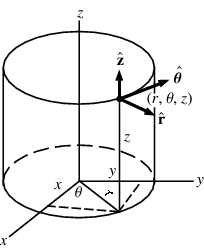To make the meaning of the equations of covariant differentiation seen in last article Introduction to Covariant Differentiation more explicit, we will consider the covariant derivative of vector V with respect to θ in cylindrical coordinates (so x1=r, x2=θ, and x3=z).

Setting β=2 in the following equation, since we are interested in the covariant derivative with respect to θ:

we get

We know the values of the first two Christoffel symbol as we have already calcuted them in the previous article Christoffel symbol exercise: calculation in polar coordinates part I

so that we already know that

We know also that since

all the symbols from the following form vanish

thus we end up with this equality
This section of the article is only available for our subscribers. Please click here to subscribe to a subscription plan to view this part of the article.

